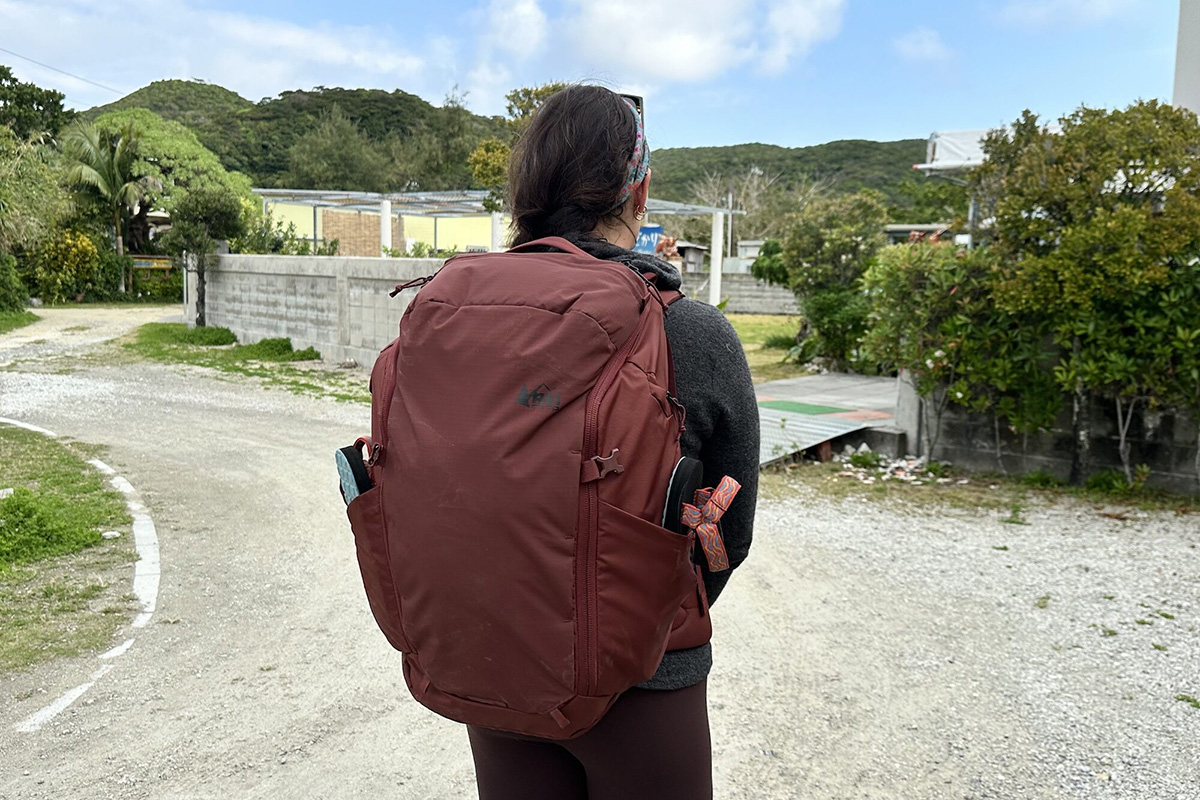
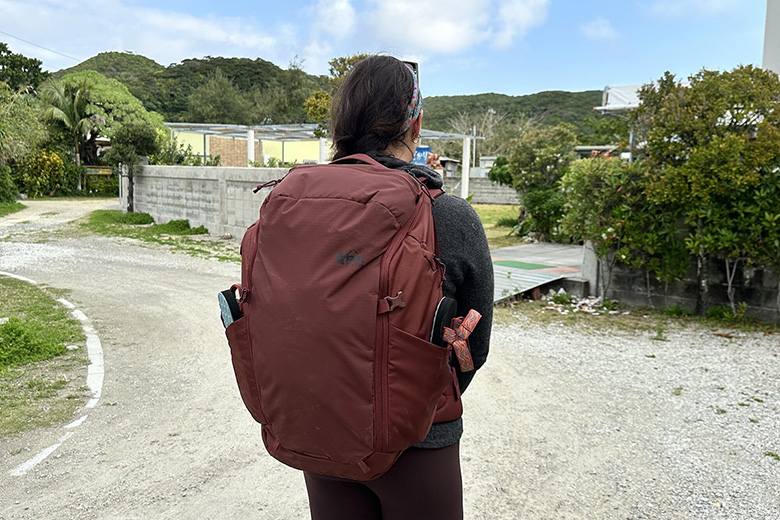
Switchback Travel (Maggie Slepian)


Switchback Travel (Maggie Slepian)
Price: $159
Weight: 2 lb. 11 oz. (women's)
Capacities: 18, 30, 40L
What we like: An affordably priced, backpacking pack-style travel bag with practical organization and great carrying comfort.
What we don’t: No dedicated laptop sleeve or internal divider in the main compartment.
See the Women's REI Ruckpack 40 See the Men's REI Ruckpack 40
For trips with a lot of moving around, I've found travel backpacks to be more convenient than rolling suitcases. I've been testing travel packs for the past few years, and the REI Co-op Ruckpack 40 is far and away my favorite. With a similar weight distribution and design as a backpacking pack—including adjustable straps, mesh paneling, and load lifters—the Ruckpack 40 features enough organization without going overboard, pairs well with packing cubes, and is a perfect carry-on size for most airlines. Below are my thoughts on the women's Ruckpack 40 after multiple international and domestic trips. To see how it stacks up to the competition, check out our article on the best travel backpacks.
Carrying comfort is my number one priority for a travel backpack. I can always make do with subpar organization and space constraints, but if I'm miserable carrying the pack, there's no chance I'll rate it highly. Thankfully, the REI Co-op Ruckpack 40 has plenty of organization and space, and it's a really comfortable carry, even when fully loaded. The Ruckpack has a lot of the same features as my favorite backpacking packs, including a well-padded hipbelt that distributes weight almost as well as a standard backcountry model, similarly well-cushioned shoulder straps, an adjustable sternum strap, and even load lifters, which help keep the weight close to my back and minimize pulling on my shoulders.
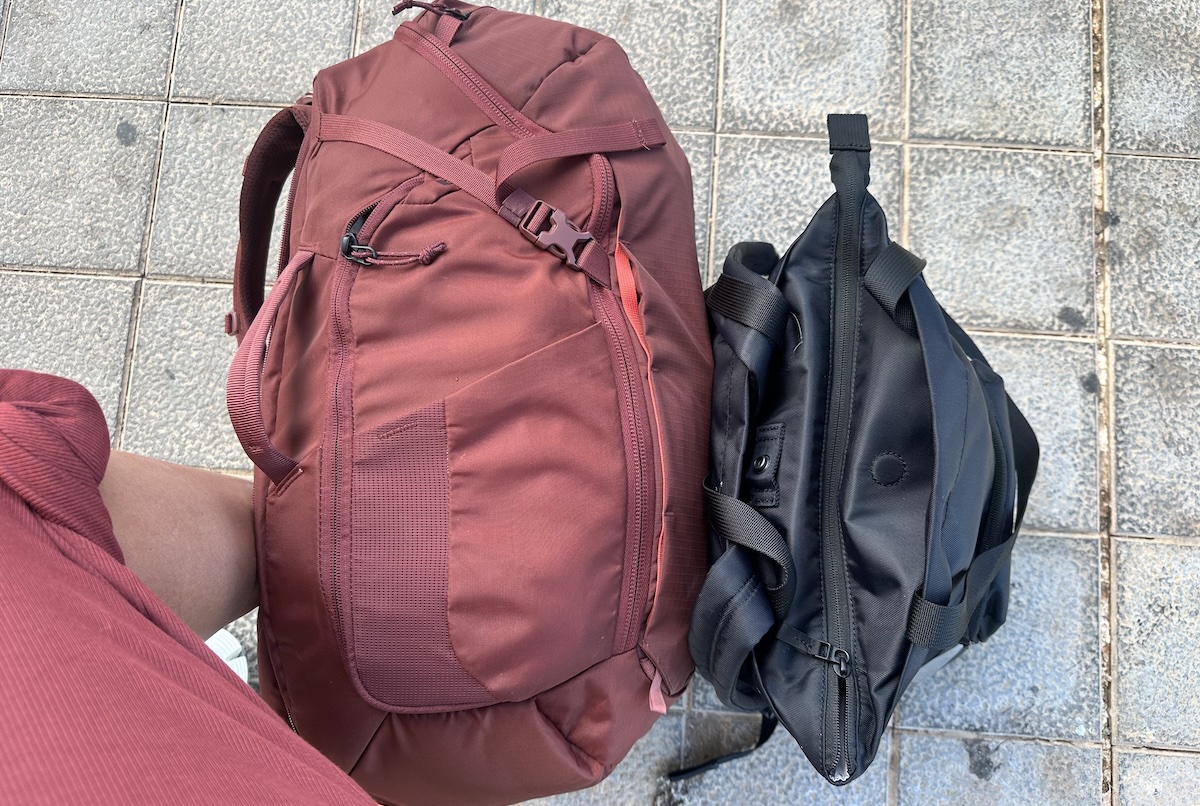
It's worth noting that I switched to the Ruckpack 40 after giving Cotopaxi's popular Allpa 42L a try. While the Allpa offered excellent organization, it was uncomfortable to carry due to its rectangular shape and ineffective weight distribution. The Ruckpack 40 eliminated these issues, with wider hipbelt placement, a higher position on my hips, and a rounded shape that felt more streamlined to pack and carry.
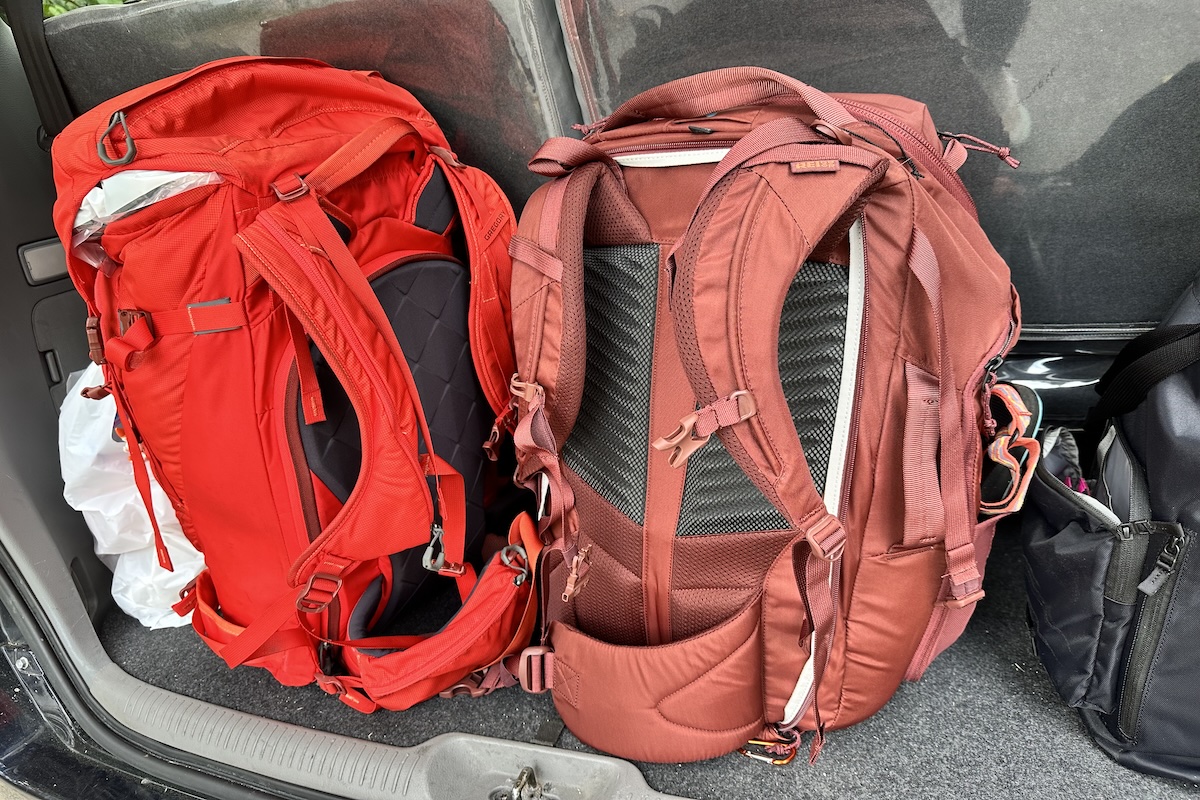
I tested the women's version of the Ruckpack 40 (it's also available in a men's model), which has a deeper S-curve in the shoulder straps that fit comfortably over my chest without squishing or sliding off my shoulders. The pack stays close to my body and feels sleeker than blockier travel packs (like the Allpa mentioned above), and the backpanel has strategically placed mesh and foam (similar to REI's own Flash 55). The sections of elevated foam stay close to my back, and the channels for airflow helped prevent claminess during a very humid week on a tropical Japanese island.
While carrying comfort is a clear strong suit of the REI Co-op Ruckpack 40, the pack also features an excellent organization layout that makes it easy to divvy up gear and clothing. I used three packing cubes in the main compartment to keep my clothes and toiletries organized. Smaller items were easy to distribute in the internal and external pockets.
Exterior Pockets
On the outside, the two stretchy mesh pockets securely fit my 24-ounce, biking-style water bottle or a pair of sandals, and nothing fell out when I slid the pack sideways into an overhead bin. The top pocket (similar to the lid on a backpacking pack) has a zipper that extends all the way across the pack for easy access and includes a clip for securing keys. One side of the pack boasts an additional pocket with an internal zipper for tucking away important items, plus another smaller drop-in pocket.
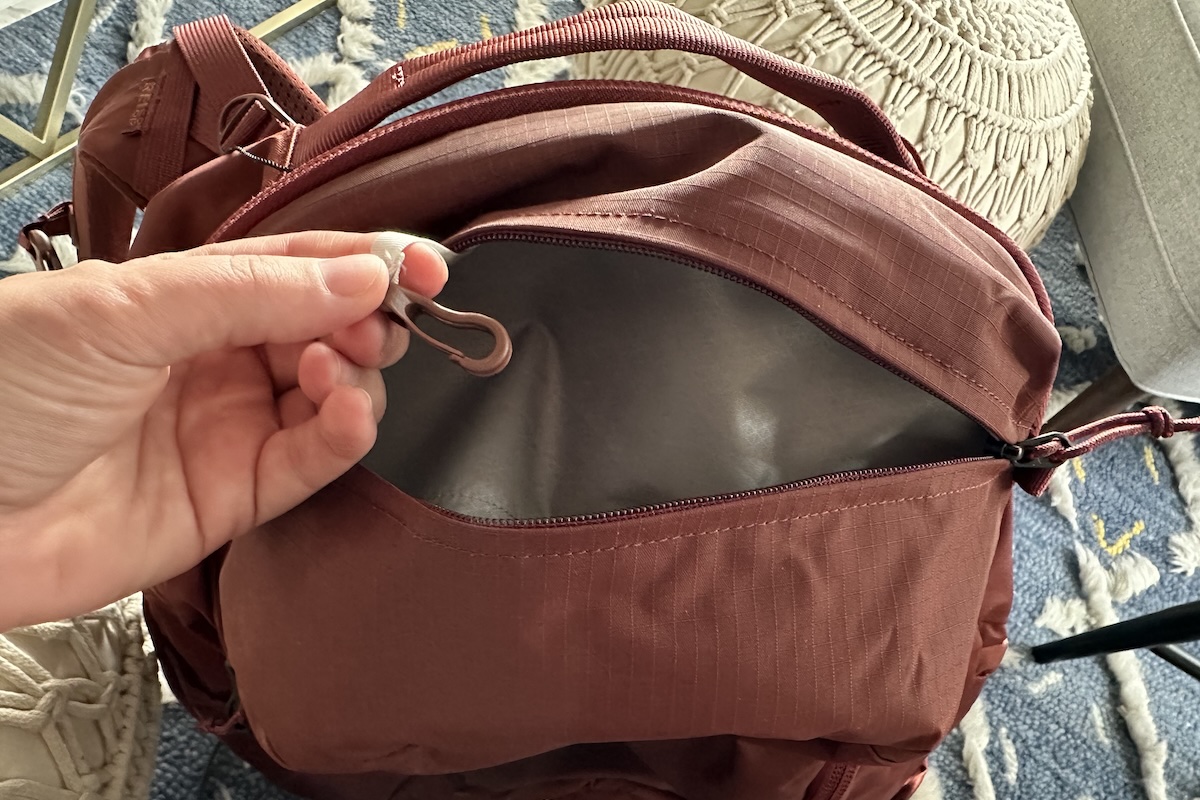
Interior Pockets
The inside of the pack has four additional pockets, not including the hydration reservoir sleeve along the backpanel. I didn't use a reservoir on my recent trip, but I slid maps and my notebook in the compartment to keep them from getting crushed. It's worth noting REI states this space can also fit a 15-inch laptop, but the sleeve isn't padded, which I'd prefer to protect electronics. Many travel-specific packs have this feature, although the REI crosses over better for hiking (especially in the smaller 18L and 30L capacities), so it may or may not be a downside for you.
The front panel has two mesh zippered pockets. I used the big one for clean socks and underwear, then put charging cables and sunglasses in the smaller pocket. A separate side zipper along the back of the pack opens for access to a mesh drop pocket, where I kept a few energy bars for easy access—no digging around required. Finally, the side pocket has a hidden internal zippered slot.
One thing people might find lacking is the lack of main compartment separation. Some travel packs, like the Gregory Border Carry-On 40, have a divider in the main compartment, which you can use to separate dirty from clean clothes or to stash shoes away from the rest of your gear. Personally, I prefer the full main compartment of the Ruckpack 40 over a divided space. While split-case designs like the Border are good for separating dirty clothes, I've found the divider often makes it hard to fit bulkier items. Plus, it's easy to create your own system by utilizing packing cubes.
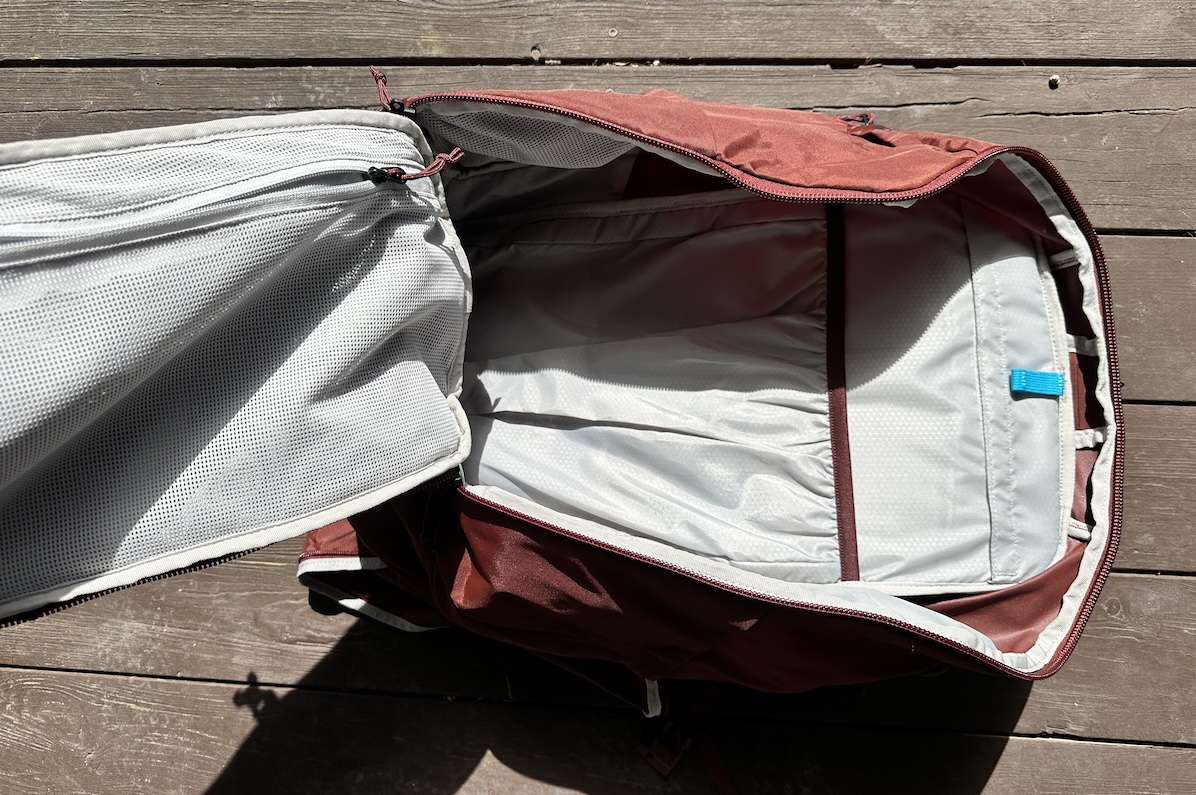
The REI Ruckpack 40's main compartment is accessed via a full-length U-shaped zipper, allowing the front panel to fall fully open. While the Cotopaxi Allpa 42 opens a little wider, I found the Ruckpack still made it easy to find items quickly. One side of the pack also features a zipper for secondary access to the main compartment, as well as the small mesh drop-in pocket mentioned above. The two exterior zipper pockets are easy to use, and the side zipper pocket has a tab at the top you can lock to keep items safe.
I also love the light-colored interior, which makes it easy to see into the bag in dim hotel rooms or at night. Since the pack has a rounded top, it can be somewhat annoying to unzip when it's in an overhead bin on a flight, so I recommend stashing items you want to keep close at hand in the zippered lid pocket and stashing the bag with the top facing out. Finally, the pack is easy to grab from multiple angles with padded handles at the top and both sides.

The REI Co-op Ruckpack 40 measures 23 by 15 by 9.5 inches, which is within carry-on limits for most airlines I've traveled with—with the exception of some budget European carriers. However, keep in mind that every airline (and the individual planes) have different-sized overhead bins, and it can be tough to squeeze a bulging backpack into some of the top-down puddle jumper bins. I haven't had an issue with a moderate load, but when the Ruckpack is full to the point of bursting, it won't fit into some smaller overhead bins. It's technically carry-on compliant, so you won't get penalized, but you might have to gate-check it.
You can also carry the Ruckpack 40 by hand. It comes with padded carry handles on the sides (though no over-the-shoulder strap), and the bottom Velcro compartment opens to reveal a backpanel cover that turns the pack into a handheld duffel bag of sorts. I like carrying it as a backpack, but some people might prefer to tuck the straps away during travel days—or in the event you have to gate-check the bag.

The REI Co-op Ruckpack 40 includes a rain cover, which comes tucked into the side pocket. I'll bring this with me if I'm heading somewhere with a heavy rain forecast and a lot of outdoor wandering, but the materials are quite weatherproof on their own, so I usually leave the cover at home to save space. The outer shell and lining are treated with a durable water-repellent (DWR) finish, which helps keep moisture on the surface, and the nylon itself is fairly water-resistant. All in all, I haven't been worried about the pack saturating, even on a bumpy ferry ride with a lot of sea spray on the deck.
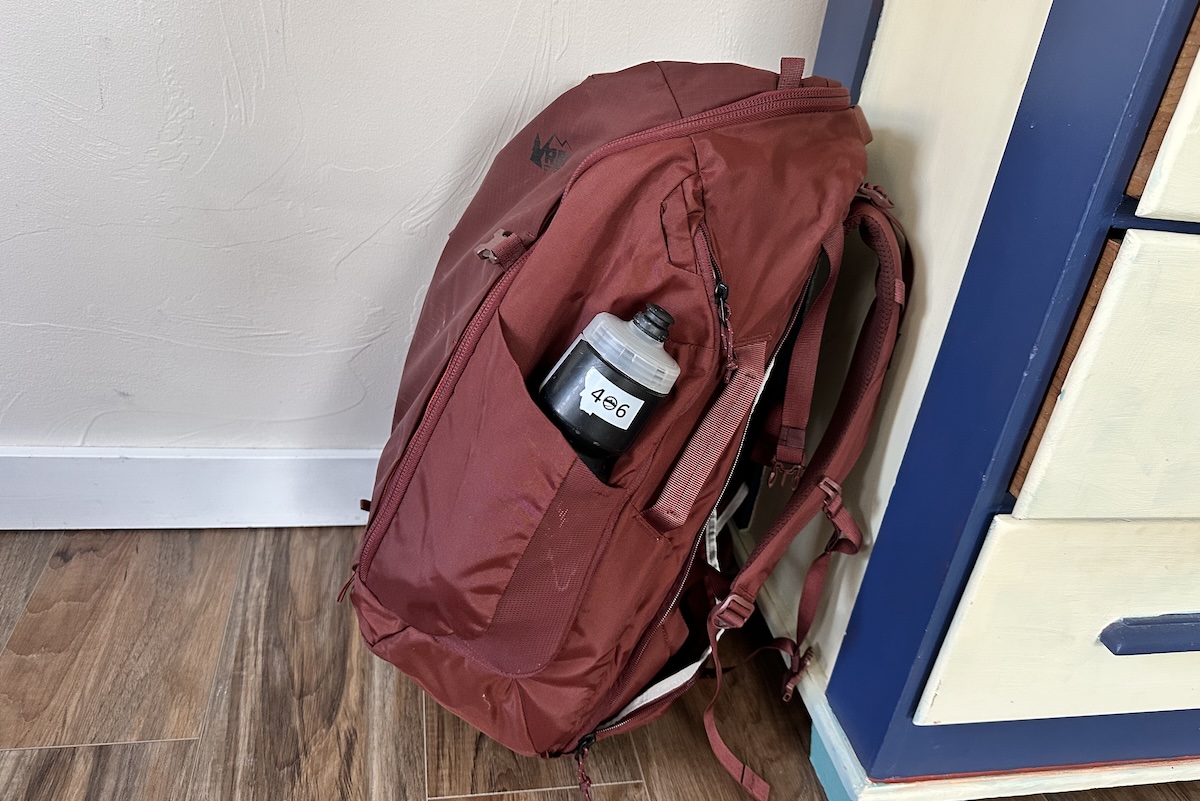
REI made an intentional choice to prioritize durability with the Ruckpack 40, which is great news for travelers who bang their gear around as much as I do. The majority of the pack is made with tough, 400-denier (D) nylon, which has proven to be well suited for everything from being jostled around in an overhead bin to getting tossed down a luggage chute. While thinner, the 200D polyester lining is also tough. The backpanel uses polyester air-mesh—the same material used on some of REI's backpacking packs. Finally, the integrated rain cover is made from 70D nylon, allowing it to compress down relatively small while still being reliably abrasion-resistant.
I've used this bag for the past year, putting it through its paces in several countries and on all manner of public transportation, and it looks almost new. The mesh has no holes, and the sturdy zippers haven't jumped their tracks. This isn't an ultralight pack, so the buckles and webbing can be a little thicker since weight isn't a priority. It's fairly comparable to the Osprey Sojourn Porter 46, but without the ultra-thick (1,680D) ballistic polyester base. I found the Sojourn Porter to be somewhat overbuilt, but for folks looking for the utmost in long-term durability, it's a good alternative.
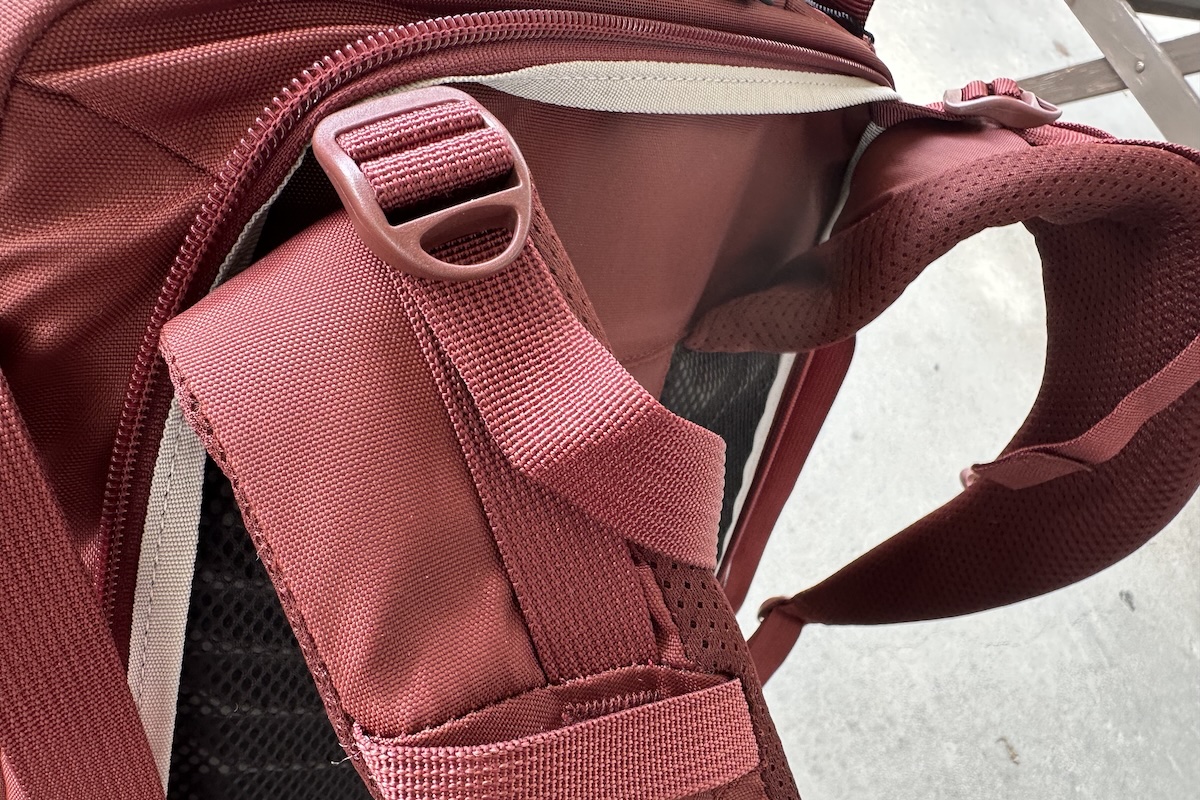
With two torso size options (XS-XL and 1X-4X) and four adjustment points (load lifters, hipbelt, shoulder straps, and sternum strap), it’s pretty easy to get a comfortable fit with the REI Ruckpack 40. Since I usually wear a women's size medium in backpacks, I opted for the smaller XS-XL option and had no complaints regarding fit. I never felt like I was short or long on room in the hipbelt, and the padding extends far along the straps. Those at the extreme ends of the size range (XS or XL, for example) may find themselves wishing for a more fine-tuned fit, but REI's size options should work for a healthy number of people.
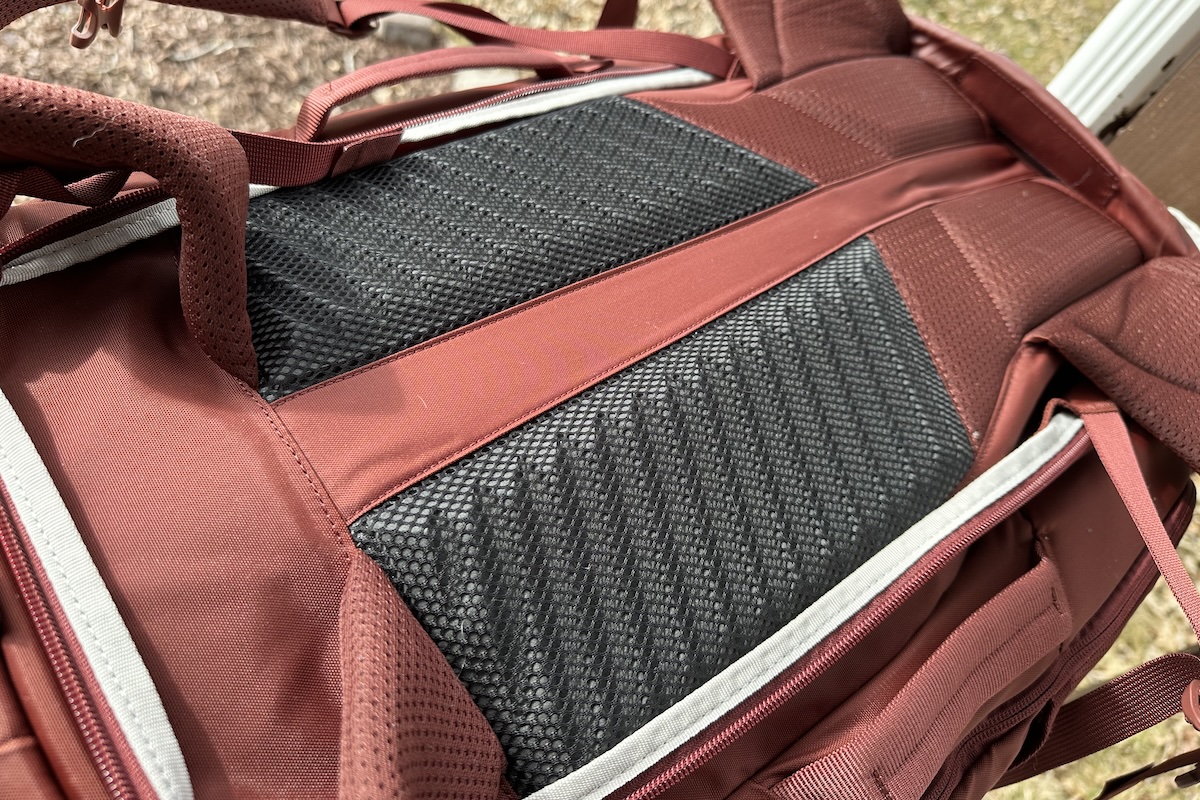
REI has worked hard to create a more sustainable line over the last few years, and their latest Ruckpack 40 is a case in point. The pack uses recycled nylon and polyester and is also bluesign-approved, meaning it was produced with minimal impact and certified as safe for workers, consumers, and the environment. The certification involves eliminating hazardous chemicals in the manufacturing process and meeting high standards for water and air emissions, among other requirements. FInally, DWR treatment is nonfluorinated, omitting harmful "forever chemicals" that are common in traditional water- and stain-resistant finishes.
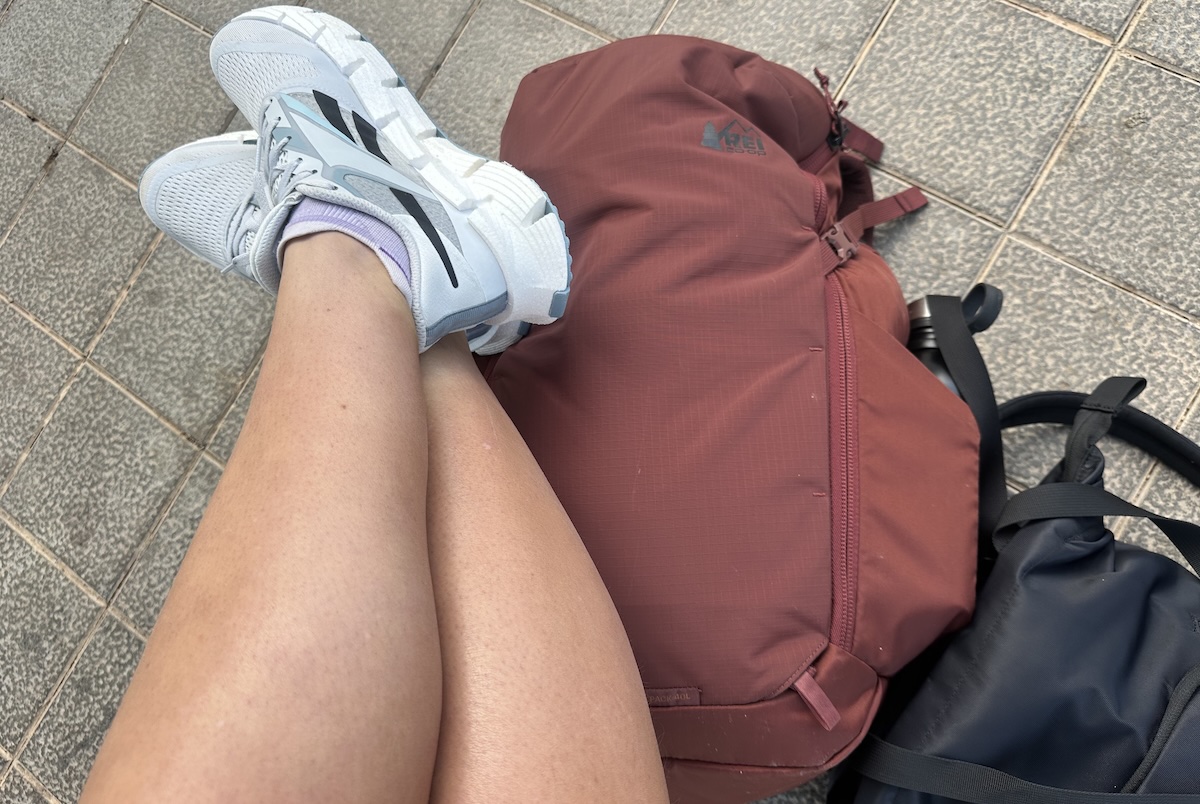
I tested the women's Ruckpack 40 on a solo trip to Spain, multiple press trips around the U.S., and—most recently—a multi-stage adventure in Japan. REI also makes a men's Ruckpack 40, which retails for the same price, has an identical overall construction and feature set, and weighs just 2 ounces more. The men's pack is offered in two sizes and fits torsos from 18 to 20 inches, compared to the women's 16- to 18-inch range. The Ruckpack also comes in smaller 18-liter and 30-liter capacities, which are nice daypack alternatives that can also be used as a personal item during travel (though the 30L is pushing it for under-the-seat storage).

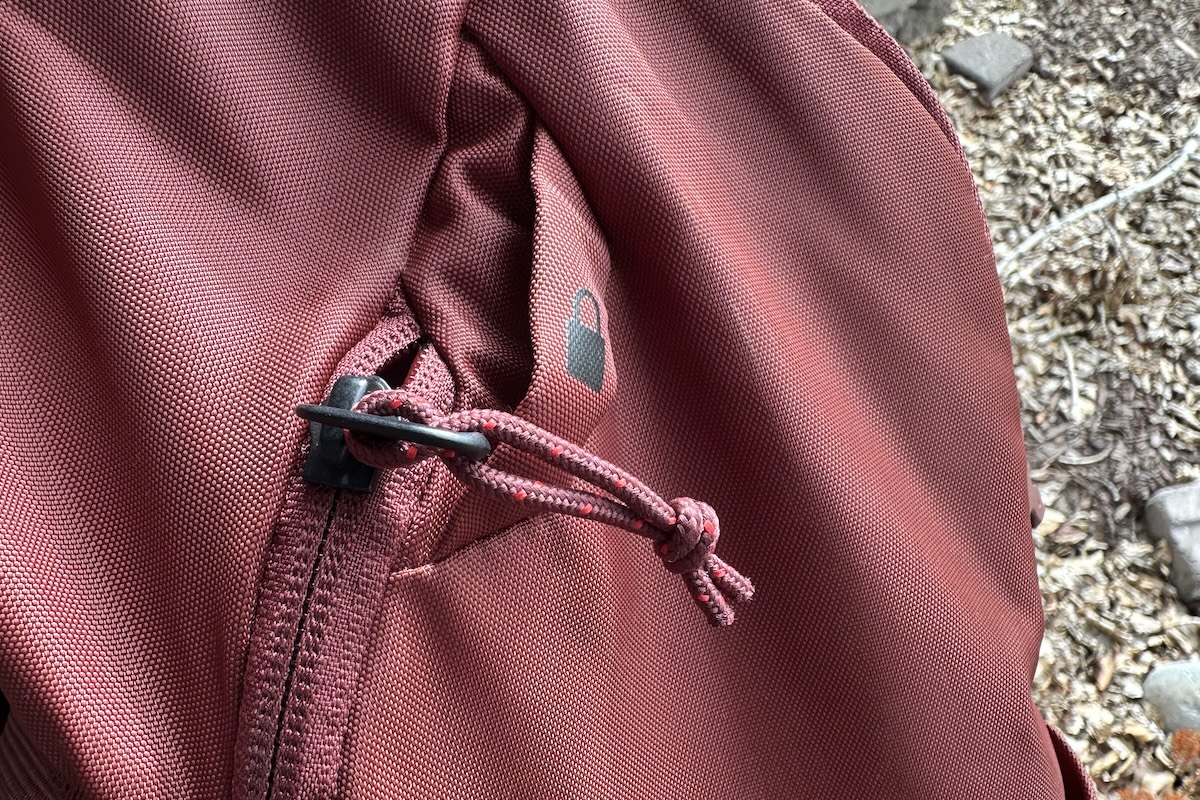
| Pack | Price | Weight | Fabric | Capacities | Dimensions (inches) | Pockets |
|---|---|---|---|---|---|---|
| REI Ruckpack 40 | $159 | 2 lb. 11.0 oz. | 400D nylon | 18, 30, 40L | 22 x 15 x 9.5 | 4 exterior |
| Osprey Sojourn Porter | $195 | 3 lb. 7.2 oz. | 460D nylon | 30, 46, 65L | 21.5 x 14 x 9 | 3 exterior |
| Gregory Border 40 | $190 | 2 lb. 14.9 oz. | 210D nylon & 450D poly | 25, 30, 40L | 22 x 14 x 9 | 4 exterior |
| Cotopaxi Allpa 42L | $250 | 3 lb. 2.0 oz. | 840D TPU/ripstop nylon | 28, 35, 42L | 22 x 14 x 11 | 2 exterior |
The Ruckpack 40 has a lot going for it, but there are plenty of options in the travel backpack category. First up is the similarly intentioned Osprey Sojourn Porter 46, which features an even burlier build with thicker fabrics and rugged flaps that buckle around the pack for added durability. The Sojourn Porter is 6 liters bigger than the Ruckpack and weighs a fairly hefty 3 pounds 7.2 ounces, though I've found both packs carry full loads very comfortably. The Sojourn Porter has plenty of interior storage, although I feel it's somewhat overbuilt, making it tough to organize all my gear in the myriad pockets. Still, if you want a slightly larger pack and don't mind spending up, the Osprey is a nice alternative.
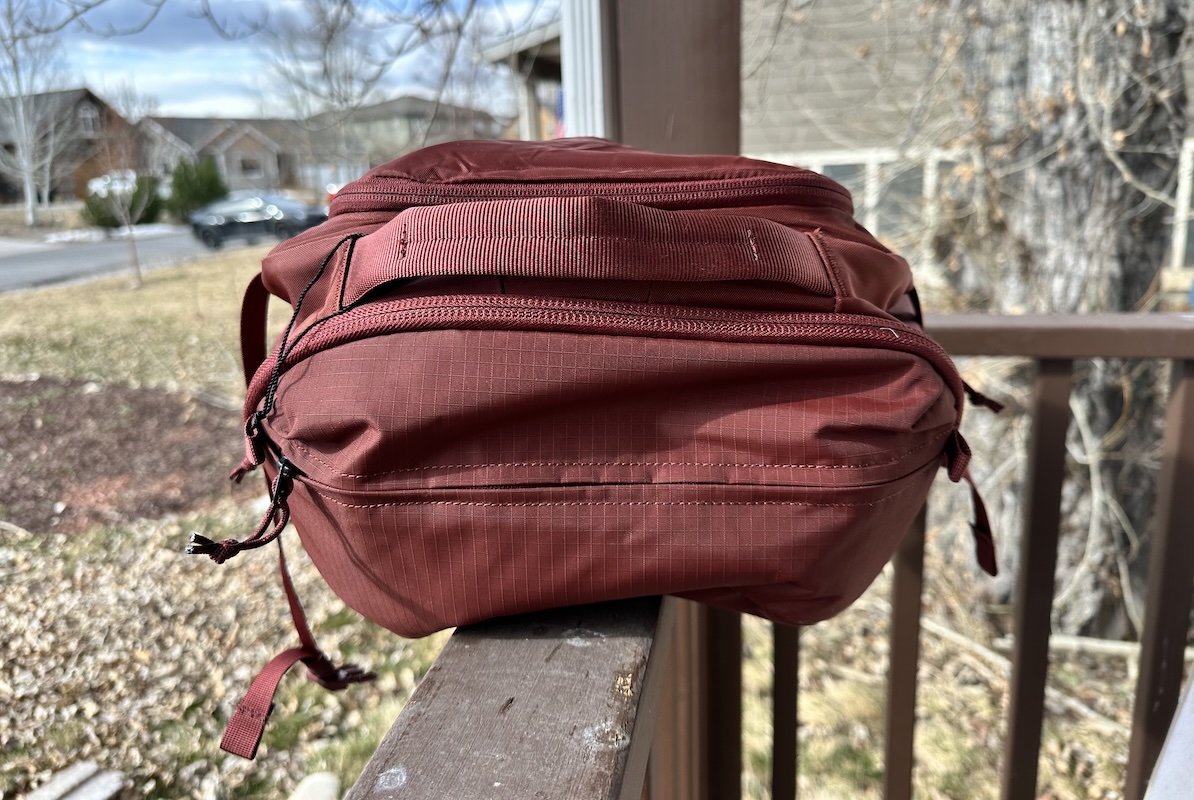
Next is the Gregory Carry-On Border 40, which feels less like a backpacking pack than the Ruckpack and Osprey Sojourn. The Border has an internal divider, which some travelers might appreciate for separating dirty clothes, plus a separate compartment for shoes. I found the Gregory harder to pack because of the dividers and also less comfortable to carry due to its boxier shape and less-padded hipbelt. In the same category, Cotopaxi's Allpa 42L is a popular design but not my personal favorite. I wore the Allpa on a 23-day, five-country trip through Europe and struggled with its load-bearing and strap design, although organization is phenomenal. The whole pack opens wide like a book, with mesh dividers on either side and smaller pockets to stash socks, underwear, and electronics.
Back to the REI Co-op Ruckpack 40 Review See Our Travel Backpacks Guide